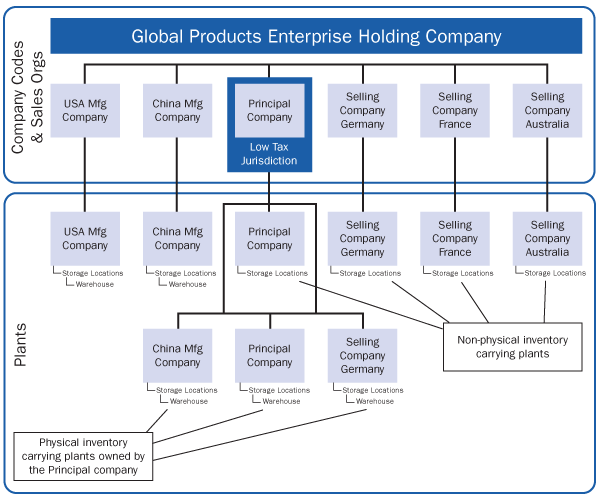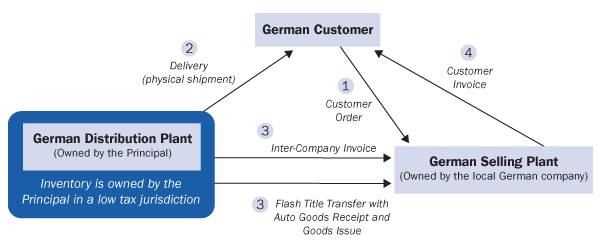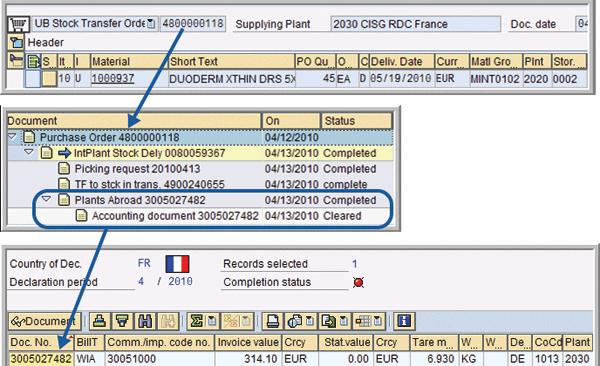With increased focus on international markets, companies running SAP are continually looking to better manage the flow of goods in a tax-efficient way to help grow their business and improve their bottom lines. Find out some best practices and financial considerations when distributing goods in international markets.
Key Concept
To reduce costs when distributing goods internationally, some companies establish a Principal – a legal entity in the lower tax jurisdiction to centrally buy and sell goods to move them through the supply chain in a tax-efficient manner to the end customer. However, the geographic location of the Principal often does not fit in with the optimal physical flow of goods. The result can be complex processes in which the financial flow of goods deviates from the physical flow. Enabling this type of distribution model can be challenging due to the increased complexity companies are required to manage. However, the financial benefit can be significant.
As the world economy becomes more integrated, company supply chains inherently become more international and complex. As a result, companies often look to less traditional ways to gain supply chain efficiencies. Reducing labor, transportation, and inventory costs and improving customer service are always a priority; however, optimizing the financial flow of goods across international markets is also an area where companies can achieve significant financial and taxation benefits.
One of the more common ways to optimize the financial flow is to establish a financially centralized distribution model that incorporates a Principal entity that is established in a lower tax jurisdiction. This type of supply chain model can help reduce a company’s overall effective tax rate when distributing goods to international markets. Whether you are looking to expand operations in international markets or better manage the financial flow of goods in international markets, understanding how SAP ERP can support a financially centralized distribution model will help you manage the increased complexity while taking full advantage of SAP ERP’s capabilities.
Enabling a financially centralized distribution model with a Principal structure is no small undertaking. It affects all core functions of a business as well as SAP ERP, including the materials management, planned production, finance, and sales and distribution modules. There is also regulatory risk that needs to be fully understood and mitigated to ensure the business restructuring is compliant with local government bodies. Because of the broad impact these initiatives have on an organization, a cross section of skills from the business, integrators, and tax experts needs to be actively involved from the outset. When the restructuring is complete, a positive byproduct is that the organization will have significantly increased its awareness of how to efficiently conduct business in various international markets and will be in a better position to take advantage of future distribution opportunities.
In this article, I’ll explain what a financially centralized distribution model is and discuss the potential business benefits and tax advantages associated with this type of model. I will present the various components of your SAP system that can help support this type of supply chain and guide you through a recent case study of a successful SAP implementation that enabled a Principal structure. Then, I’ll present some key considerations and pitfalls to watch for when using SAP ERP to manage these distribution-related financial processes.
Benefits of a Financially Centralized Distribution Model
When distributing goods internationally, companies are careful to consider their operating structure and strategy for the physical flow of goods as equally important as the financial flow. A common approach to managing the distribution of goods across multiple countries is through a Principal.
The Principal is usually responsible for purchasing goods from internal or external manufacturing entities and then selling the goods to other operating companies located in the various end customer markets through intercompany sales. The local operating companies then perform the final sale to the end customers. If properly set up, this sequence of intercompany and end customer sale transactions can help to reduce a company’s overall effective tax rate. Figure 1 compares a traditional international distribution model with a financially centralized distribution model using a Principal structure.

Figure 1
A traditional distribution model compared to a financially centralized model
It is important to note that the process of establishing and maintaining a financially centralized distribution model with a Principal is far more than just an accounting setup activity. In order for a Principal to play a role in the distribution process and receive profit, it must take on certain business functions and assume an appropriate amount of risk to justify the associated profit. The structuring of the relationship and terms between the Principal and the local selling companies needs to take into account the level of added value performed by each party and levels of risk assumed by each party. Properly setting up the operating and legal structure of the Principal and the local selling companies helps determine the amount of compensation that should flow to the various parties. A general rule is the more risk and business functions performed by the Principal, the larger the amount of profit can be retained by the Principal.
Examples of types of risk that you need to consider among a Principal and local selling companies are:
- Inventory ownership risk – risk related to capital investment in inventory
- Obsolescence risk – risk related to products in inventory becoming obsolete
- Credit risk – risk related to customers’ ability to pay
- Currency exchange risk – risk related to currency fluctuations
- Recall risk – risk related to product recalls
Beyond tax savings, companies often look to gain operational efficiencies through centralizing key business functions at the Principal. Examples of these types of business functions include:
Represent a Financially Centralized Distribution Model in SAP ERP
To successfully deploy and manage a centralized distribution model using SAP ERP, it is very important to get the underlying organization structure represented correctly. The key organizational elements in SAP ERP that are required to support the model are company codes, sales organizations, plants, storage locations, and warehouses. Be sure to fully understand both the physical flow of goods and financial flow before finalizing the organization structure and configuring into SAP ERP. Because SAP ERP tends to assume the physical flow of goods matches the financial flow, it is important to have complete knowledge of all transactions that support processes where the financial flow deviates from the physical flow on a day to day basis. Figure 2 shows an example SAP organization structure that supports the centralized distribution model that was shown in Figure 1.

Figure 2
Example SAP organization stucture to support a financially centralized distribution model
Transfer Pricing
Before I discuss the business scenario, I need to explain a core element of the model: transfer pricing. Transfer pricing is the accepted mechanism for allocating profits when buying and selling goods between entities within a multinational enterprise. With each intercompany buy/sell transaction, transfer pricing determines what the intercompany profit will be.
As you can imagine, properly setting up and maintaining a compliant transfer pricing arrangement is a key part of any international distribution model. Since transfer pricing arrangements are subject to audit, it is critical that transfer pricing specialists are fully involved in any distribution model restructuring initiative. Transfer pricing specialists should have deep knowledge of the local regulatory requirements for each relevant government body to ensure the entire distribution model is compliant.
Figure 3 is a simple transfer pricing example related to the distribution model presented in Figures 1 and 2. Figure 3 also helps demonstrate how a Principal structure impacts a company’s overall tax obligation.

Figure 3
Transfer pricing example within a financially centralized model
Business Scenario
I was recently involved with a successful SAP implementation at an international medical device company. In addition to implementing all core supply chain, finance, and order-to-cash functions, the project also included implementing a financially centralized distribution model with a Principal structure.
Figure 4 shows the high-level process flow of the successful implementation. The implementation involved establishing a Principal in Switzerland to centrally manage the procurement and distribution of goods to the end-customer markets. Business functions that were centralized at the Principal include demand planning, inventory management, procurement of finished goods, and various EU tax-related reporting functions.
The six steps I present and discuss in Figure 4 both guide you through the physical process and information flow and highlight some best practices to keep in mind when using SAP ERP in this type of distribution model.

Figure 4
How SAP can support a financially centralized distribution model
Step 1. Demand planning. End customer demand is forecasted on a monthly basis and loaded into SAP ERP as independent requirements via interfaces from a forecasting application. SAP ERP’s daily materials requirement process (MRP) and special procurement keys automatically aggregate demand at the Principal from the distribution centers. The aggregated demand is then reviewed by the Principal and passed to the manufacturing entities for detailed production scheduling again using SAP ERP’s MRP process and special procurement keys.
Step 2. Detailed scheduling and manufacturing. With the agreed-upon production requirements from the Principal, the manufacturing entities develop their detailed production schedule, procure additional raw material as necessary, and produce the finished product.
Step 3. Allocation and intercompany purchasing. Once the finished product has passed inspection and is released from quality hold via a usage decision, the Principal allocates stock to replenish specific distribution centers (DCs) owned by the Principal. Intercompany Purchase Orders are created and predetermined transfer prices are automatically pulled in from intercompany info records. Stock is then picked and issued from the manufacturer and placed in transit against an Outbound Delivery.
Step 4. Goods receipt and inventory management. Once the goods arrive at the various DCs, they are received and placed into stock. An intercompany invoice is then processed from the manufacturer using the predetermined transfer price. Inventory ownership now belongs to the Principal. Throughout the process, the inventory retains its original production batch and expiration details for shelf life management and recall purposes.
Step 5. Customer order entry and fulfillment. Customer orders are collected and entered by the various selling companies. Customer orders are then passed to the appropriate Principal-owned DCs for fulfillment. The DCs then ship direct to the end customers using an Outbound Delivery.
Step 6. Flash title intercompany sale and end-customer invoicing. Once the customer order has been fulfilled by a Principal DC, the intercompany flash title process (ownership changes hands for only an instant) takes place to pass ownership of the inventory from the Principal to the selling company using another predetermined transfer price as presented in Figure 3. This process enables end customer revenue and profit to flow to the selling company while incorporating a behind-the-scenes intercompany sale transaction with the Principal.
Supporting Flash Title Sales in SAP ERP
In certain situations, it is advantageous to incorporate the flash title sales process within a financially centralized distribution model. For example, incorporating flash title sales is useful when inventory owned by the Principal is being shipped directly to the end customer and the selling organization — where the sales order was captured — belongs to a different company code.
To support this process, it is necessary for the goods to properly change ownership from the Principal to the selling company before being sold to the end customer. For tax purposes, the valued inventory needs to appear as an asset (if only for an instant) of the selling company since they are performing the end sale to the customer and recognizing the customer revenue. For example, if a customer is ordering product from a company in Germany but the product will be shipped directly from a warehouse owned by the Principal in Germany, the ownership of the goods needs to first transfer from the Principal to the German company before being sold to the end customer. This is an example of the financial flow deviating from the physical flow. You can use the flash title sale process to properly record the intercompany sale to the German selling company before the final sale is made to the end customer. Figure 5 shows a diagram of a flash title sale based on this scenario.

Figure 5
Intercompany flash title sale to support a financially centralized distribution model
To help minimize the amount of manual transactions that are required to perform the necessary goods receipt (GR) and goods issue (GI) through the selling company, it is possible to leverage existing BAPIs to automate the GR and GI. This can enable the ownership of goods to properly pass through the selling company without a lot of manual virtual transactions. This automated flash title process should generate two goods movements, one for a GR into the selling company followed immediately by a GI out of the selling company. The GR and GI movements should use the same data, such as materials, batches, and quantities.
If an automated flash title process is set up, it is important to also properly set up a trigger so your SAP system knows when to automatically perform the flash title set of transactions. One way is for the trigger to retrieve the shipping plant’s company code from the outbound customer delivery and compare it to the company code associated with the sales order via the associated sales organization. If they are a predefined combination, the flash title routine should be triggered automatically.
If you choose to pursue an automated solution to support an intercompany flash title sale, be sure to thoroughly test every from/to scenario and make sure all intercompany financial documents are generated correctly and have the proper accounting and tax information. It is critical that all intercompany financial postings are accurate to ensure the overall financially centralized distribution model is working as expected.
Special Considerations
Besides the normal challenges of restructuring distribution processes and implementing new technology, there are some special considerations project teams should take into account when implementing this type of distribution model with SAP. One such consideration is the use of SAP’s Plants Abroad functionality and another is integrating SAP ERP with third-party logistics providers. Let’s look into each of these in detail.
Plants Abroad
For organizations that have multiple plants within the European Union under the same company code but have multiple VAT registrations (each EU country requires a separate registration), SAP ERP provides standard functionality called plants abroad to assist with the proper tax postings and intra-European trade statistics reporting (INTRASTAT). In cases where the sending and receiving plants belong to the same company code but are located in different countries within the EU, the flow of goods (via stock transfers) is subject to internal EU trade statistics reporting. This scenario is common for companies that employ a Principal structure within the EU.
With plants abroad enabled, SAP ERP can facilitate the proper VAT determination and reporting obligations in each country. Figure 6 shows the underlying FI-related documents that get generated for a stock transfer scenario when plants abroad is enabled for both the sending and receiving plants.

Figure 6
Plants abroad accounting documents
Integrating SAP with Third-Party Logistics
Companies that distribute goods to a variety of international markets and leverage a financially centralized distribution model often use third-party logistics to manage the physical distribution to their end customers. Because third-party logistics already have established distribution operations, they can provide a company with a relatively fast and cost-effective way to set up distribution in remote markets. Third-party logistics can also be used to manage Principal-owned DCs as part of a financially centralized distribution model. Even though the inventory is owned by the Principal, third-party logistics can be used to manage the physical inventory as well as the customer order fulfillment process.
A challenge to using third-party logistics is often the accompanying systems integration that is required. However, if done correctly, companies can maximize the benefit of using third-party logistics through timely and accurate information exchange. The size and complexity of the distribution operation will often drive the level of integration complexity. However, typical interfaces companies use when integrating SAP ERP with a third-party logistic include the following:
- Material master (SAP ERP updates third-party logistic)
- Expected receipts/purchase orders (SAP ERP updates third-party logistic)
- Goods receipt confirmation (third-party logistic updates SAP ERP)
- Inventory adjustments (third-party logistic updates SAP ERP)
- Outbound deliveries (SAP ERP updates third-party logistic)
- Outbound delivery confirmation (third-party logistic updates SAP ERP)
- Inventory reconciliation (daily comparison between third-party logistic and SAP ERP inventory balances)
A pitfall to watch for when integrating with a third-party logistic is making sure production batch and expiration details are properly tracked at the third-party logistic and kept in synch with SAP. It is tempting to just manage inventory on a quantity basis at a third-party logistic. However, when inventory is batch-managed with expiration dates, it is a best practice to maintain batch and expiration traceability throughout the whole process with full visibility in your SAP system.
Don’t Forget About Returns
It is important to mention that properly handling returns in a financially centralized distribution model with automated flash title sales needs to be fully thought through. Because of the imbedded intercompany buy/sell transactions, processing returns can be more difficult to manage than in a straightforward selling scenario. Be sure to understand and account for all possible return scenarios and get an estimate of the expected volume. If the return volume is expected to be high, it may warrant setting up an automated return flash title process leveraging the same logic as discussed above but in the reverse direction.
Bryan Fricke
Bryan Fricke is a senior managing consultant with IBM’s Global Business Services. He works on supply chain management challenges with an emphasis on warehouse operations/warehouse management solutions. He has implemented both SAP and non-SAP warehousing systems. You may email Bryan at bryan.a.fricke@us.ibm.com.
If you have comments about this article or publication, or would like to submit an article idea, please contact the editor.











